
The Kombu or Kompu also known as the Kombu Pattu is a wind instrument (a kind of Natural Horn) in Tamil nadu and Kerala. Usually played along with Panchavadyam, Pandi Melam, Panchari melam etc. This musical instrument is usually seen in south India. The instrument is like a long horn (Kombu in Tamil and Malayalam).
Puliyattam (means Tiger Dance) is an old folk art dance of Tamil Nadu. A highly exuberant and cultural festival, this dance form usually comprises a troupe of 6 performers aping the movements of the majestic, predatory tigers.
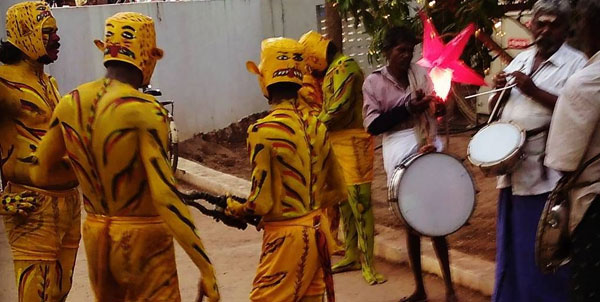
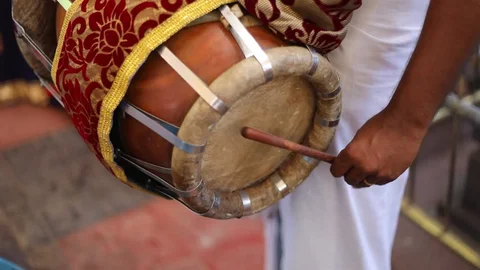
This article is about musical instrument. For the chemical compound, see melam (chemistry). Melam is a group of Maddalams and other similar percussion instruments’ (Chenda) rhythmic performance. Those who play melam are called ‘Melakaar’. In ancient Tamilakam (Tamil country) melam was used for all the occasions in temples (Kovil Melam, Naiyandi Melam, Urumi Melam), marriages (Ketti Melam), functions, funeral wake(Parai Melam). In Kerala the most traditional of all melams is the Pandi Melam, which is generally performed outside the temple. Another melam called the Panchari Melam, which is similar to Pandi Melam, but the Panchari Melam is played inside the temple.
Karagattam dance form of Tamil Nadu state is one of the ancient folk dances. This dance is a prototypical way of praising the deities, along with carrying the beautifully adorned pots. Dancers of Tamil Nadu state practiced this dance to praise the river and rain deities. The musical tune of this dance is aesthetical because of the songs and musical instruments. The dancers of the Karagattam dance balance the water pot on head and they dance with musical rhythm with that pot. The unique feature of this dance form is handling water pot on the head and doing the dance. The Karagattam dance contains 2 different parts Sakthi karagam and Atta Karagam. The field of Aatta Karagam is restricted only within the holy Temples of Tamil Nadu state, another part Sakthi Karagam is practiced by the dancers in temples and also public platforms. The major aim of Karagattam dance is jubilation, Karagattam dance’s both the types are tremendously famous in the entire Tamil Nadu state.
Kavadi Attam or more popularly Kavadi is a dance performed by the devotees of Lord Murugan, the Hindu God of war. The word kavadi in Tamil means ‘carrying weight on shoulders’. In Kavadi Attam dance, the devotees carry the burden on their shoulders and dance; and give their offerings to Lord Murugan. This dance is performed during the Thaipusam festival.
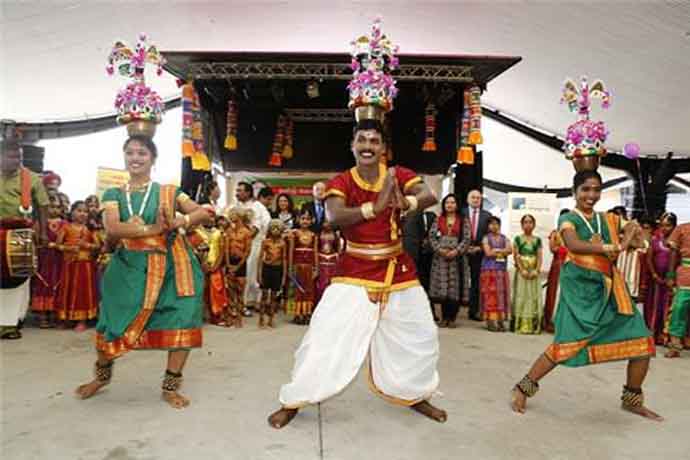
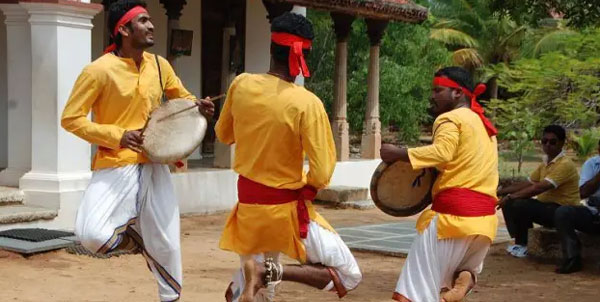
Thappattam is a musical art form of Tamil Nadu where the folk music and songs are worldwide celebrated and eminent for their unique style and rhythm. The day-to-day life of the people who have a rural base and the various phases of their life are accompanied by folk music. Thappattam is one such art form. Thappattam is a unique form of folk dance that is performed with the thappu, a drum that is used by the suppressed Dalit class people of Tamil Nadu. Thappattam is supposed to be the most vibrant and attractive form of dance in the state. The rhythm and drumbeats vary and the drums make different sounds during the festivals as well as during burial ceremonies. Thappattam has sincerely gained much attention with the passage of time and it is being used by modern theatre practitioners in social festivals, educational institutions, formative dance, cultural nights, and many other programs.
Silambam’s main focus is on the bamboo staff. The length of the staff depends on the height of the practitioner. Ideally, it should just touch the forehead about three fingers from the head, typically measuring around 1.68 meters (five and a half feet). Different lengths may be used depending on the situation. For instance, the sedikuchi or 3-foot stick can be easily concealed. Separate practice is needed for staffs of different lengths. Listed below are some of the weapons used in Silambam.
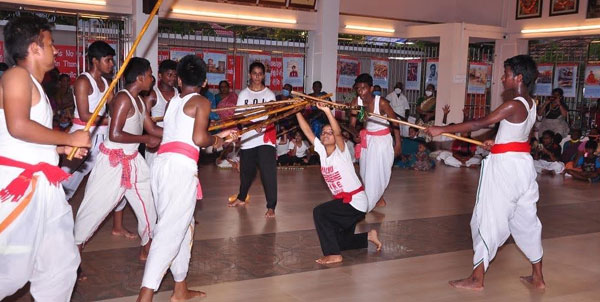

Fake horse is a game played by pretending to ride on a horse harness . The game is said to have originated in Thanjavur. Male and female dressed as Raja Rani and dancing.
It is also known by other names like Puraviyattam, Puravi Natyam, and Poik Khoor Atam. The game is called the game of false horse because it is performed standing on a wooden leg while carrying a false horse’s saddle. The game is known as Saithikoda or Gayuta in Orissa , Thilukurram in Andhra Pradesh , Kachikodi in Rajasthan , and Khonkakali in Kerala . Historians say that this game came to Tanjore during the time of the Maratha kings .
This art is widespread in Tamil Nadu. This art is temple and community art. Earlier they used a musical instrument called kondalam for this game. Now this play is performed to satirical music. Those who perform this art act as kings and queens. The stage of this art is procession , performed to the background music of Naiyandi Melam . Of all the places where the procession goes, the front of the temple is also. This game takes part in Hindu temple festivals, Muslim festivals and Catholic Saveriar temple festivals.
Kummi is a folk dance, popular in Tamil Nadu and Kerala in India, danced mostly by South Indian women in circle. Dancing may be different. In some places, it is very simple, with rhythmic clapping or beating of the drums. In other places dancers imitate various harvesting activities. Kummi often accompany by songs, called “Kummi songs”. It is often danced during festivals. It is also danced by Tamils of Sri Lanka. Kummi songs became a popular addition to kuthiyottam festivities in modern times. The word “kummi” has originated from the Tamil “kommai”, meaning dance with clapping of hands and had originated at a time when instruments were not invented. One village woman starts a popular song while others join in with singing and clapping to keep note of time. Songs are performed by the women dancing in circles. Men, when they join form the outer circle.
Kolaattam dance is an ancient village folk art performed in the Tamil Nadu state of India. It is also called as Kolannalu or Kolkolannalu. This dance form is famous in all parts of Tamil Nadu. Kolaattam is performed only by women. This folk dance is an amalgamation of rhythmic movements, songs and music. This dance form is performed during local village festivals. It offers a great variety of entertainment not only to spectators but also to the participants. Kolaattam is also performed in other states but is known by different names in different states of India.
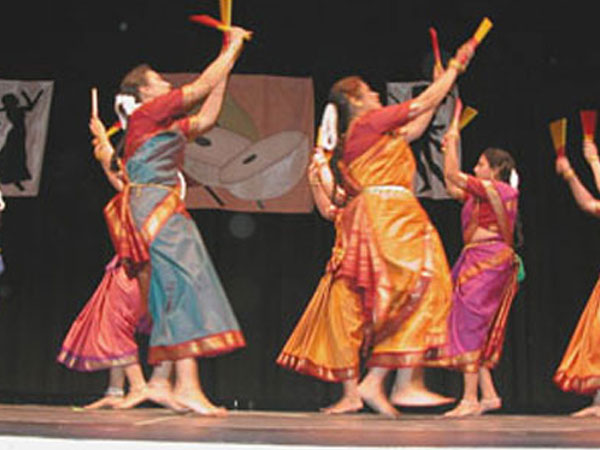
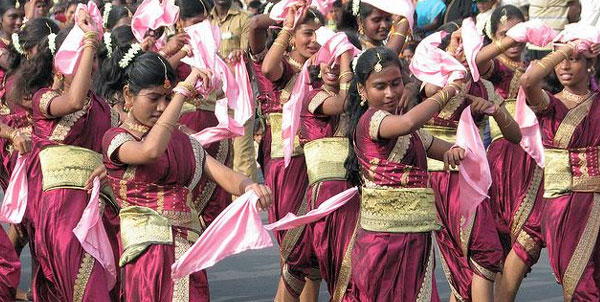
Oyilattam (meaning: dance of grace) is a folk dance with origins in the Madurai region of Tamil Nadu. The dance has its origins in southern Tamil Nadu and is primarily performed in Madurai district, Tirunelveli district and Tiruchirapalli district. It was traditionally a dance where a few men would stand in a row with two kerchiefs perform rhythmic steps to the musical accompaniment, with the number of dancers increasing; over the past ten years women have also started performing this dance. Typically, the musical accompaniment is the Thavil and the performers have coloured handkerchiefs tied to their fingers and wear ankle bells. Oyilattam is one of the folk arts identified for mainstreaming by the Tamil university. Mainly Oyilattam is performed at village festivals. It is a dance used after harvest to protect the grains from birds.
As per the legend, the demon Thanjan got boon from Lord Shiva and became very powerful. He was troubling the Devas who had inhabited the site where the temple is currently located. The Devas sought Shiva’s help. Lord Shiva sent his consort to help them. The Goddess took the form of Pachai Kali (her complexion in green color) and started fighting the demon. However, the demon started taking different forms and was reappeared crore (kodi) times. Kali became very ferocious and turned red in color and was called as Pavala Kali. As she ultimately killed the demon who took kodi forms, she was named as Kodi Amman. The blood of demon flew as river and as it was reflecting in the body of Goddess, her body turned into red, as per another version. As per the request by Thanjan to the Goddess, the place was named as Thanjavur.
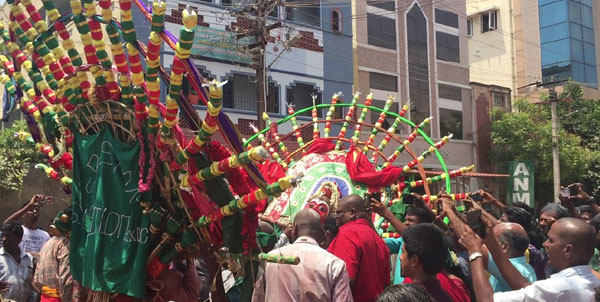
The Thanjavur Tourism Promotion Council has launched a WhatsApp Channel specifically for Thanjavur Tourism. Kindly invite your friends interested in exploring Tourism & Heritage to join us. Let’s contribute to the promotion of Thanjavur Tourism together!
Copyright © 2023 Thanjavur Tourism Promotion Council. Developed & Hosted by YOGA’S IT Solutions.